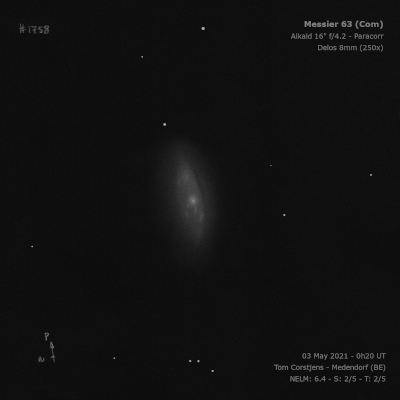Sunflower Galaxy
Sunflower Galaxy

Pierre Méchain discovered M63 = NGC 5055 = h1570 on 14 Jun 1779. On 18 Mar 1787 (sweep 717), William Herschel recorded "E from np to sf., 5 or 6' long and near 4' broad, a bright nucleus, very brilliant." On 9 Apr 1787 (sweep 725) he logged "vB, 9 or 10' long, considerably broad, the brightness confined to a small place." JH logged "B; pmE; vsmbM, almost to a *, pos 30° np to sf. The sf end more diffused. Has a bright star np and a double star following."
On 9 Mar 1850, LdR (or observing assistant George Johnstone Stone) noted M63 was "another fine and bright spiral." Later observations couldn't confirm the spirality, though the galaxy is included in the list of 14 "Spiral or curvilinear" nebulae in LdR's 1850 PT paper.
Basen on Mt Wilson 60-inch photographs, Pease (1918) described M63 as a "bright, beautiful spiral 8' x 3' in p.a. 98°. Has an almost stellar nucleus. The whorls are narrow, very compactly arranged, and show numerous almost stellar condensations."
300/350mm - 13.1" (5/26/84): very bright, elongated NNW-SSE, broad moderate concentration, stellar nucleus. The southern edge is more sharply defined while the northern side is more diffuse and extensive. A mag 8.5 star is off the NW edge.
400/500mm - 17.5" very bright, large, elongated 2:1 WNW-ESE, 6'x3'. There is a faint outer extension to the WNW (outer spiral arms?) that reaches extremely close to mag 8.7 SAO 44530 just 3.7' from the center.
900/1200mm - 48" (4/20/17): This gorgeous spiral is sharply concentrated with a bright, mottled oval core that increases to an intensely bright nucleus. Several low contrast dust lanes surround the core, particularly on the south side of the core, separated thin sections of spiral arms. A long, relatively broad dust lane crosses the halo E-W, roughly 2' south of center. A very low surface brightness arm or section of the outer halo is visible beyond (south) of this dust lane. A mag 9.3 star is superimposed in the outer halo [3.7' WNW of center].
48" (4/7/13): The "Sunflower Galaxy" is a classic example of a floccelent spiral with many short fragments forming the arms. At 375x it appeared extremely bright and large, elongated 2:1 WNW-ESE, 8'x4'. A large, intense, mottled core increases to a small, brilliant nucleus. The outer halo was resolved into several tightly wrapped spiral arcs that are separated by thin dust lanes. The arm structure is most evident along the south side of the galaxy with the easiest arm at the outer edge, particularly where it separates at the western end. The galaxy extends just beyond a mag 9.3 star (HD 115270) at the northwest edge.
UGCA 342, probably a detached section of the outer halo of M63, lies 8' WSW of center and 1.2' S of a mag 10.7 star. It appeared extremely faint, fairly small, elongated 2:1 E-W, 20"x10", very low surface brightness.
Notes by Steve Gottlieb